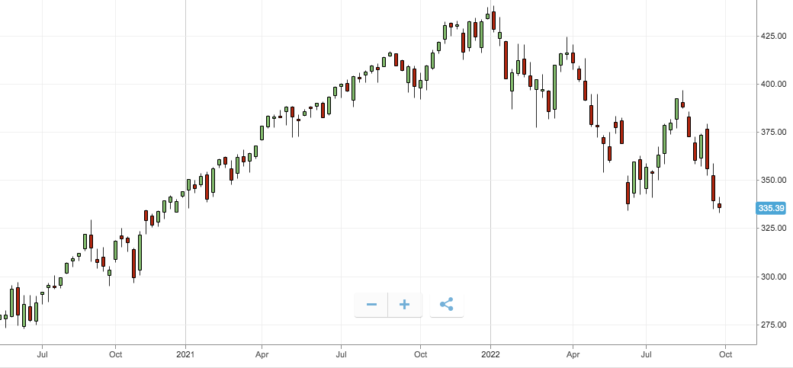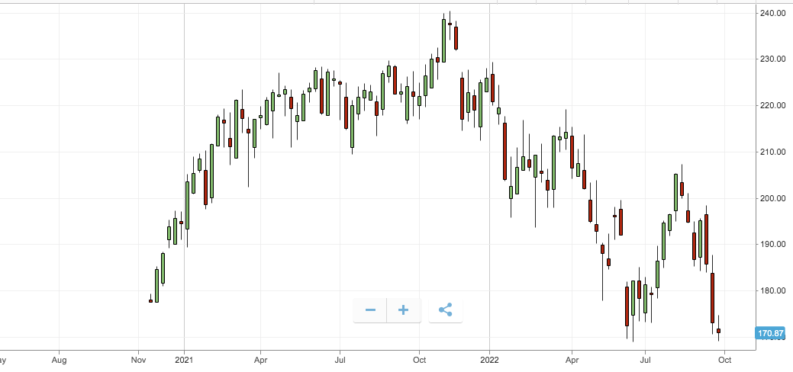At times you might find that your portfolio is not delivering on the objectives or goals you set out when you first started investing. Here we will look at some ways to rejuvenate your portfolio in order to keep up with the market and ensure that you’re able to reach your investing goals.

eToro is a multi-asset investment platform. The value of your investments may go up or down. Your capital is at risk.
If you find that your investment portfolio is consistently falling behind the key benchmarks, expenses are piling up and dragging down your profits, or the swings in your daily profit and loss don’t match the risk you’re willing to take on, there are avenues for you to take to rejuvenate your investment portfolio.
By applying some simple portfolio management techniques bedded in proven mathematics, you can match benchmarks, stem the outflows, and dampen the swing of your portfolio.
At the outset of any investment, it is important to lay out what you hope to achieve. Are you investing for retirement and require a steady appreciation of your assets or an income stream? Or are you willing to take a chance on higher returns at the risk of higher losses? Outlining a plan is as vital as the execution and measurement of your strategy.
If your execution is not matching up to your overall goals, then it is time to take action and make some adjustments to your portfolio. Indeed, if you’re looking to turn around a losing portfolio or boost sub-par returns, read on as we reveal a shortlist of actions you can take to rejuvenate your investment.
Small vs. Large Companies
Perhaps you’re a long way from retirement, willing to take a chance on the market and looking to add some investments in the corners of your portfolio that will have a chance to appreciate considerably.
If this is the case and you are looking to add smaller companies to your portfolio, these firms are likely to face stiffer competition, confront market barriers to entry for their product and have uncertain funding. The transition from small to big can be inherently risky.
All listed small companies want to become big listed companies. The difficult transition from small to large will see many companies fail in their objective along the way. Though, of course, the odd one makes it and will make handsome returns for the investor.
The loss rate for small companies is quite high. In particular, this is the case when you consider the obstacles to forging out a market and creating the kind of competitive moats and capital backstop that assure a future. Picking a winner from the multitudes of small companies that won’t make it can be quite a difficult task.
ETFs – The Portfolio Effect
An alternative method to participate in small company growth, and rejuvenate your investment portfolio, without the risk of losing it all on a single name is by buying a share in an exchange-traded fund (ETF) that selects a basket of small companies.
The portfolio effect of a group of companies in an ETF can work in much the same way that a school of fish gathers together for security. As a single target, they might be easily picked off, but in a school, their individual chances improve without compromising on speed and manoeuvring.
There is an inevitability in losing a number of small companies to the challenges of business. However, by buying an ETF rather than a single name, there is a good chance that the weighted average of the names in the ETF will appreciate more quickly than the loss rate.
Vanguard Small-Cap ETF NYSE:VB (VB) is an entry point for the investor to small-cap growth participation. Bundling a number of companies with a median market capitalisation of $5.4bn.
Vanguard VB- Weekly Price Chart – 2021–2022
Source: eToro
eToro is a multi-asset investment platform. The value of your investments may go up or down. Your capital is at risk.
It should be noted that VB is on the risky side of ETFs and falls into Vanguard’s more aggressive strategy buckets. A common tool used in finance to measure the ‘risk’ aspect of stock investment is Beta.
Gauging Beta
Beta refers to the volatility of the share price and can be used when comparing and contrasting certain investments. The Beta on VB is higher than on Vanguard’s S&P 500 ETF NYSE:VOO (VOO), weighted holdings from the S&P’s largest companies.
VOO Beta is currently 1, compared to the more risky VB of 1.13. These, in turn, are much lower than the Beta’s of single names in either ETF. For example, Diamondback Energy NASDAQ:FANG (FANG) is a holding of VB and has a Beta of a high 2.06. Suggesting the stock will move 2 dollars for every 1-dollar movement in the overall market.
Selecting winners is challenging no matter how long you’ve been investing, selecting winners over multiple years compounds the difficulty. Small to big doesn’t happen overnight and those that were once winners could fall to the wayside.
VB is an avenue for the investor to add some velocity to your portfolio when the market is rising without risking it all on a single up-and-comer.
Vanguard VOO- Weekly Price Chart – 2021 – 2022

Source: eToro
eToro is a multi-asset investment platform. The value of your investments may go up or down. Your capital is at risk.
Transaction Expenses
When trading, it is important to set out your objectives and follow through with any plan – creating limits to profit and stopping out when losses become too great, for example. When trades don’t go your way, work out why and ensure that any oversight isn’t repeated.
One of the biggest terminal mistakes that any novice trader can make is overtrading – not learning from mistakes and repeating ad nauseam in failed attempts to claw back losses.
Not only is over-trading a fast way to burn capital, but it is also costly at the point of execution. Transaction expenses can add up quickly, particularly on illiquid or irregularly traded single-name stocks and securities.
There are a number of ways to keep on top of transaction expenses. Firstly, ensure you’re using a trusted and reputable broker. eToro and IG are valued for their customer protections and low transaction fees.
Secondly, stick to the main highways of regularly traded stocks and securities. If you are looking for side-roads of less well-known trades, it is more likely that you will pay over the odds for execution. By trading in large capitalisation names like Apple Inc or Microsoft to start with, your transaction fees will be moderated.
Thirdly and finally, when you’re unsure which name to choose from a basket of securities or want to build the portfolio effect of a diversified group of stocks, perhaps you should again be thinking about an ETF.
As we’ve covered already, an ETF is an excellent and cost-effective way to get exposure to a group of securities. The breadth and depth of these funds in today’s market are such that any grouping you could possibly think of has been bundled into an ETF.
Diversification
If you find that your portfolio is not moving in lockstep with the market or if you’re having a down day when your peers are all celebrating big gains, then you may want to look at diversifying your portfolio.

Source: iStock
eToro is a multi-asset investment platform. The value of your investments may go up or down. Your capital is at risk.
By diversifying your portfolio, you spread out your investments and can bring in elements that you might not have thought of before. If you’re currently set up for growth, perhaps you’d like to add a reliable dividend income component as you transition towards retirement.
Diversification is not only an excellent way to moderate the risk (Beta) of a single name, but also could be the stepping stone you need as a trader to rejuvenate your investment portfolio. Very few companies are perfectly correlated in price and will move up and down as winners in the business sectors are decided over time.
Diversification can refer to buying a number of companies competing in the same market, but you’re unsure of which product will be the ultimate winner. It can also refer to buying stocks in industries that are competing for market share. For example, buying an oil company and also a solar voltaic producer to hedge your investments.
Finally, diversification of your portfolio can mean buying stocks and shares in completely unrelated industries and markets. Maybe the US market is slowing and you are considering investing in Indian stocks as you value their near-term growth opportunities.
Whether you’re looking to moderate or increase your risk profile or align to new products or markets, diversifying your portfolio by adding a new basket of securities will allow your portfolio to keep up with, if not beat, the average market returns.
Rebalancing Your Portfolio
You’ve spent some time uncovering a winning strategy, built a trusted portfolio of shares that behave to match your investment goals, and you have faith that the future is bright for the companies you’re holding. But what if the returns or income on the account are not exactly as you wish? It could be time to consider rebalancing your portfolio.
Making small and spaced adjustments to your existing portfolio, selling a few shares here and buying a few more there, could be a great way to not completely overhaul a winning portfolio but to extract just a little more value to meet your trading goals.
Rebalancing is something that is required periodically as businesses delve into new markets, sell off legacy sectors, or are faced with new competitors. The natural growth of businesses needs to be reflected in your portfolio weighting to ensure that the level of risk you are comfortable with is not exceeded.
If, for example, one of the holdings in your portfolio grows too rapidly, it may be prudent to sell off a percentage to ensure that the risk profile of your portfolio doesn’t become uncomfortable.
Final Thoughts
In today’s marketplace, winners and losers in business are decided more and more quickly. The prudent investor needs to move with the times and ensure that the winners and losers of the enterprise are not unsettling their investment goals.
Overhauling, diversifying, rebalancing, and assessing the performance of the portfolio is as crucial to success as the first day that the shareholder decides to make an investment in the company.
Before making any changes to the balance of your portfolio, ensure that you understand what the impact of the change will have on your outcomes. Consult AskTraders’ list of recommended brokers to assess whether their services could be key to helping you to rejuvenate your investment portfolio.














